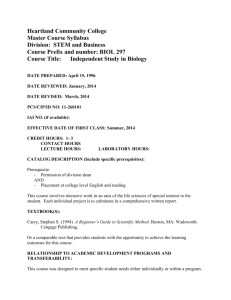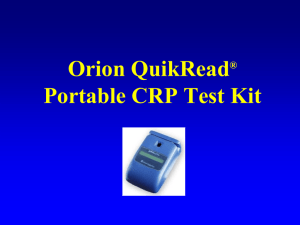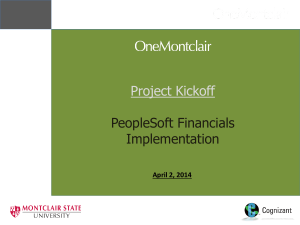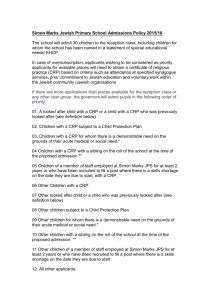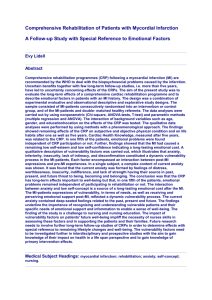6 A Spatial Economics Decision-making Guide for Conservation
advertisement
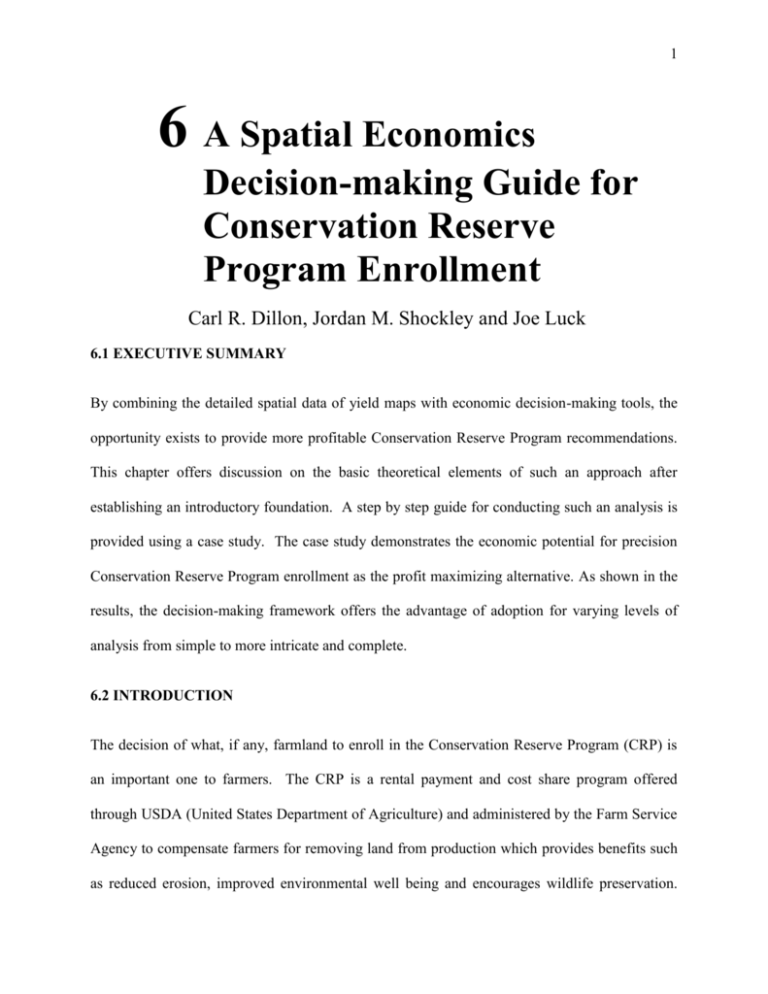
1 6 A Spatial Economics Decision-making Guide for Conservation Reserve Program Enrollment Carl R. Dillon, Jordan M. Shockley and Joe Luck 6.1 EXECUTIVE SUMMARY By combining the detailed spatial data of yield maps with economic decision-making tools, the opportunity exists to provide more profitable Conservation Reserve Program recommendations. This chapter offers discussion on the basic theoretical elements of such an approach after establishing an introductory foundation. A step by step guide for conducting such an analysis is provided using a case study. The case study demonstrates the economic potential for precision Conservation Reserve Program enrollment as the profit maximizing alternative. As shown in the results, the decision-making framework offers the advantage of adoption for varying levels of analysis from simple to more intricate and complete. 6.2 INTRODUCTION The decision of what, if any, farmland to enroll in the Conservation Reserve Program (CRP) is an important one to farmers. The CRP is a rental payment and cost share program offered through USDA (United States Department of Agriculture) and administered by the Farm Service Agency to compensate farmers for removing land from production which provides benefits such as reduced erosion, improved environmental well being and encourages wildlife preservation. 2 As such there is a market failure that can be rectified through CRP wherein society (the government) pays farmers for enhanced environmental stewardship. This provides economic incentive to the farmer and offers the potential for greater profitability than producing on the land that is eligible for CRP enrollment. Geographical information systems can provide opportunities for more accurate decisions regarding enrollment of land in CRP through yield maps. The possibility for economic decision-making tools and spatial information provided by yield maps to help guide the choice of CRP enrollment has been developed and researched previously (Stull et al. 2001, Stull et al. 2004). Such a selective, analytical approach of precision CRP enrollment has potential for superior economic performance over simply enrolling all land eligible for CRP. Furthermore the concept of precision CRP enrollment has been expanded to include wildlife conservation (McConnell et al. 2010) as well as whole farm economic optimization (Dillon and Shockley, 2010). However, an instructive guide to such procedures is still needed. Therefore, the purpose of this chapter is to demonstrate the application of using spatial yield data in economic analysis to guide CRP enrollment decisions. Evidence of the potential for greater water quality benefits under CRP through the incorporation of spatial information in establishing conservation buffers has been found (Dosskey et al. 2005). Similarly, the potential of precision conservation techniques for reducing nitrate leaching has been identified and studied (Delgado and Bausch 2005). Thus, the benefits to society through heightened environmental well being under the augmentation of precision information guidance in CRP exist. Additional elements of environmental impact of CRP have been considered in the recognition of the importance of potential enhancements in soil productivity as a result of CRP participation (Ribaudo et al. 1989). It is imperative that a decision-making guide for CRP enrollment demonstrates adequate flexibility to modification 3 under dynamic conditions as policy changes to incorporate growing bodies of understanding of the mechanics and consequences of environmental and economic issues of CRP. Such is the intent of the decision-making tool to be presented herein. The economic elements of CRP inherently give rise to factors complicating the decisionmaking process for farmers considering enrollment. The difficulty arising from the lag of CRP payment levels relative to rising rental rates remains an issue today under rising crop prices as it was in a 1998 study by Cooper and Osburn. Components of contract design and their economic implications have been investigated (Wu and Guan 2009) and might serve as a mechanism to help farmers dealing with this problem of disincentive for CRP enrollment when facing a lagging, low CRP payment level relative to expected profitability from continued production. Uncertainty in general, as well as the issue of decision irreversibility in CRP participation, also has been recognized and studied from an economic perspective (Isik and Yang 2004). While facing some forms of uncertainty, it should be recognized that the CRP has inherently displayed benefits to farmers beyond the opportunity for increased profitability. One such example is the opportunity for a farmer to reduce production risk by receiving the certain, constant CRP payment as an alternative to the uncertain yields and market prices associated with the alternative of continued production on CRP eligible land. The multitude of economic considerations in CRP enrollment strengthens the justification for the demonstration of a flexible, albeit simple, decision-making tool which combines economic criteria with the added accuracy and subsequent societal and individual farmer benefits possible with spatially defined information. 6.3 METHODS Farmers face a multitude of decisions and frequently the choices they make among competing alternatives are based upon the economic consequences of those decisions. In turn, the economic 4 consequences are based upon the underlying production environment. It is not surprising that production economics decision-making models often can serve as a helpful guide in making these decisions. The methods will follow the development of a production economic decisionmaking tool by examining four elements. First, the underlying economic theory is established as a basic framework. This serves as a base for the development of a more practical and useful planning tool, the partial budget and subsequent breakeven analysis. Spatial elements inherent in precision agriculture are then embodied in the development of net returns maps. The combination of these geographic information systems (yield maps or net returns maps) may then be coupled with economic criteria to culminate in a spatially depicted decision guide useful in the delineation of areas recommended for CRP enrollment. 6.3.1 Output Substitution Theory A farmer considering CRP enrollment essentially is choosing between the production of two outputs – environmental enhancement and the corresponding governmental payment for CRP participation or the alternative crop (e.g., corn or soybeans) with subsequent net returns possible from the production and marketing of that crop. Therefore, the decision to enroll in CRP implies an opportunity cost of foregoing the production of agricultural commodities on the farmland in question. Consequently, a classical output substitution (enterprise combination or crop mix) is an appropriate theoretical framework for making the decision of what land to enroll in CRP. In an output-output (or output substitution) model, we define the physical tradeoffs between different outputs or products. This relationship, commonly referred to as a production possibilities frontier or production possibilities curve, depicts the possible combinations of efficient production of outputs (i.e., commodities) for the given set of constant resources or inputs (factors of production) available to the producer. This may be represented in many 5 different ways including graphically as shown in the example displayed in Figure 6.1. This simple two output model includes the two alternatives of crop production, specifically corn, and the enrollment in CRP as germane for our purposes here. Notably, the maximum level of corn production corresponds to no enrollment in CRP while some corn production is of course still possible under maximum CRP enrollment as not all land farmed is eligible for the program. While the physical possibilities are herein represented, the decision of what to produce between the two alternatives requires adding economic data. Specifically, the goal of the farmer may be considered in this case as one of maximizing gross revenue (GR). Thus, the effective prices for the two alternatives are multiplied by the amounts produced of the two goods and combined to account for total gross revenue. Thus, the producer maximizes gross revenue to the point that it is still physically achievable resulting in the optimal output mix (Figure 6.1). Graphically, this is the tangency point between the gross revenue line and the production possibilities curve (PPC) which requires equivalency of the slopes of both. Mathematically, this is where the marginal rate of transformation (the slope of the PPC which depicts the rate at which one output can be transformed into the other) is equal to the output price ratio (the slope of the gross revenue line). Depending on the curvature of the PPC and the effective out prices, the economically optimal level of CRP enrollment can be no enrollment, maximum eligible enrollment or some level in between. 6.3.2 Partial Budgeting and Break-even Analysis While useful as a theoretical framework, the underlying economic output substitution model may be embodied in a more useable economic decision-making tool in the form of a simple partial budget. A partial budget is a farm management planning guide which summarizes the changes in profits associated with a proposed change to a whole farm operation. Consequently, it is an 6 appropriate and practical tool for the consideration of CRP enrollment. It offers the advantage of providing an analytical framework for making decisions by focusing solely on the aspects of the farm plan that are affected by the proposed alteration. Negative impacts on profitability in the form of additional costs and reduced revenues are subtracted from positive changes in profitability (additional revenues and reduced costs) to determine a net change in profit. Changes which would result in a lower expected profit (net change is negative) are disregarded as unfavorable. If net change in profitability is zero then the decision maker would be indifferent to making the proposed change. For the example at hand, the costs of CRP enrollment (additional costs of grassy strip establishment and maintenance as well as reduced revenue from foregone crop sales) is subtracted from the benefits of CRP (additional revenue from government payment and reduced costs from crop production) to establish the net change in profits. An example partial budget for CRP enrollment may be found in Table 6.1. Notably, for this example a positive change in profit is indicated inferring that a switch from corn production to CRP enrollment would be profitable in this instance. Notably, while an average yield for all CRP eligible could be used, precision conservation concepts would allow for geographical information systems to be applied for a more accurate assessment of the profitability of CRP enrollment. Thus, the use of yield data varying spatially is desirable. Naturally, the development of a partial budget for every point on a farm field is nonetheless unattractive. Fortunately, the dilemma is easily rectified by the calculation of the break-even yield required to justify CRP enrollment as developed by Stull et al. (2004) or through the use of spatially dependent net returns estimations as discussed in the next section. We note from the partial budget that the farmer is economically indifferent to CRP 7 enrollment at the point where there is a zero net change in profits (wherein marginal benefits are just equal to marginal costs from CRP enrollment). Specifically, this is: Equation 1. CRP + VC – EST – P*Y = 0 Where: CRP = Conservation Reserve Program Payments including cost share for vegetative buffer strip establishment and maintenance, VC = variable cost of crop production removed due to enrollment, EST = annualized establishment and maintenance costs for vegetative buffer strip, P = crop price and Y = crop yield. All elements other than crop price are measured per unit of land area (e.g., ha or ac). By simply solving this equation for yield, one can determine the break-even yield, or yield at which the farmer neither makes nor loses money as a result of CRP enrollment. This gives: Equation 2. (CRP + VC – EST) / P = Y This a powerful concept in that this break-even yield can then be compared spatially on a yield map to highlight profitable versus unprofitable areas of the field for CRP enrollment. Specifically, for areas of the field where the expected crop yields are greater than this break-even yield level, expected profits would be greater by remaining in crop production. For lower yielding areas of the field, CRP enrollment would provide greater expected profitability than the alternative of remaining in crop production. 6.3.3 Net Returns Mapping A yield map can serve as an excellent tool in farm management decision making. It can, however, be expanded into a net returns map which visually depicts the profits (more correctly net returns above specified costs) on a spatial basis. At the simplest level, this can be straightforward accounting of crop price multiplied by the spatially dependant yield (gross 8 revenue by location) less specified costs. Specified costs could be total costs reflecting both operating costs (such as seed, fertilizer, fuel) and ownership costs (such as machinery depreciation and interest on machinery investment) per unit of land area (e.g., ha or ac). Alternatively, specified cost might represent only operating costs or some select costs of relevance. Conceptually, the estimation of components within a net returns calculation could become more accurate and involved as desired with supporting data. For example, variable rate nitrogen application would necessitate the spatially dependent costs of nitrogen as applied. Likewise, costs which are yield dependent (e.g., grain drying) could conceivably be reflected spatially. Furthermore, it is possible to consider the alteration in machinery performance across the field (such as for headlands or changes in speed due to slope) and the corresponding changes in machinery costs. Such a net returns map has considerable possibilities in farm management applications including the identification of less profitable areas of the field. Where CRP eligible areas of the field have net returns inferior to CRP payments, a farm manager should consider enrollment. One advantage of the use of net returns maps for the delineation of areas for CRP participation is that an average across multiple years of crop rotation is permitted through a common unit (dollars) while averaging different crop yields (such as corn and soybean) is not relevant to this decision. Ultimately, the inclusion of economic criteria is critical in the decisionmaking process whether that step be done as part of the spatial depiction directly (i.e., net returns maps) or as a means of establishing a breakeven yield criteria for use with a yield map. 6.3.4 CRP Enrollment Delineation The analytical framework has been established through the merger of the above elements of economic theory, economic planning tools and geographic information systems as a conceptual process for guiding the CRP enrollment decision. Notably, a desirable feature of the analytical 9 framework lies in the power for it to be implemented at different levels. On a relatively simple level a producer could get a precision agricultural consultant to make a yield map highlighting areas above and below the breakeven yield calculated using the formula developed above. On a more intricate level a producer might develop one’s own CRP enrollment recommendation map. As an example procedure for this, the case study discussed in the next section provides a stepwise procedure for doing this. It should be recognized, however, that the potential exists for expanding the concept to incorporate complexities such as farmer risk attitude and impacts of varying forms of land acquisition (ownership versus rental) as evident in Stull et al. (2001). The optimal level and location of precision CRP enrollment is indeed affected by the farmer’s attitude toward risk and the form of land tenure (Stull et al., 2001). As mentioned above, the CRP payment, as a constant source of income which is not weather dependent, effectively reduces the risk borne by the farmer relative to the alternative of producing a crop which has fluctuating yields. It is therefore unsurprising that greater levels of aversion to risk by farmers lead to more land enrolled in CRP. Thus, even if some land is slightly more profitable remaining in production, a risk averse farmer may choose to forego production and enroll in CRP to avoid the yield variability associated with production. Land tenure also has impacts on CRP enrollment. Some tenant farmers have approached land owners with the idea of encouraging them (the land owners) to enroll in CRP on low yielding areas but consider reducing rental rates. Of course, a crop share rental arrangement would result in lower rent for the tenant farmer under CRP enrollment given the reduction of total farm yield. Land tenure naturally affects the optimal percentage of CRP enrollment from the farmer’s perspective. Greater levels of land is enrolled in CRP under land ownership while reduced benefits to the farmer under crop share arrangements leads a desire of the farmer to enroll less land in CRP. While crop share rental 10 arrangements embody a sharing of production risk between the land owner and the farmer tenant, the potential for CRP enrollment to further reduces risk is still evident. This means farmers, whether land owners or tenants, with greater aversion to risk would still wish to enroll more eligible land in CRP than their risk neutral counterparts. 6.4 CASE STUDY A case study of vegetative filter strip CRP enrollment is examined as an example application of the economic precision conservation enrollment decision-making guide in the accomplishment of the primary objective of this chapter. This is accomplished through a description of the case study used, presentation of the stepwise procedure used and a discussion of the resulting CRP enrollment recommendations. 6.4.1 Background The economic decision-making process often entails gathering underlying physical data, collecting relevant economic data and then applying the appropriate economic decision-making criteria. The case of CRP enrollment delineation is no exception. The physical data required is embodied in the yield maps for the area being considered for CRP enrollment. As an example application of the decision-making tool, the case study of corn yield data for a cooperating farmer in Shelby County, Kentucky is used. The corn is planted in two year rotation with double cropped soybean and wheat production under no-till conditions as common in Kentucky row crop agriculture. The field being considered is 11.51 ha (28.44 ac) and is largely comprised of a *** soil and displays a gently rolling topography. Raw crop yield monitor data was filtered for measurement error and inappropriate anomalies in the data using the same criteria of Stull et al. (2004). Specifically, combine data standards include filtering for usable combine speed 11 (allowing a range of 63.5 to 355.6 cm or 25 to 140 in per second), moisture level (10 to 25%) and mass flow (less than 170.25 kg or 75 lbs per second). The filtered crop yields for the example resulted in a mean of 7998.45 kg/ha (127.43 bu/ac) with a spatial standard deviation of 1791.38 kg/ha (28.54 bu/ac). With the physical yield map data established, the question of needed economic data arises. Crop prices, crop production costs and CRP related data regarding payment levels and vegetative buffer strip establishment and maintenance costs are required. A 2011 expected median corn price less basis and hauling costs was used for this study resulting in $0.1677/kg ($4.26/bu). Corn production costs from Halich (2011) were used for this study, but excluding cash rental charges, resulting in $928.99/ha ($376.11/ac). Similarly, the annualized establishment and maintenance costs associated with a grassy vegetative filter strip is taken from Stull et al. (2004) and updated to 2010 using the producer price index to account for inflation resulting in a level of $30.90/ha ($12.51/ac). Notably, 50% of these establishment and maintenance costs are offset as part of the cost share elements of CRP and such is reflected in subsequent analysis. The CRP payment beyond this cost share is at a level of $363.09/ha ($147.00/ac) for the case at hand. With physical and economic data collection completed, the next step in the decision-making process of applying the economic decision rule is conducted as outlined in the next section. 6.4.2 Stepwise Procedure The existence of two alternate procedures is embodied with the analytical framework. One is a simpler approach wherein a break-even yield for CRP enrollment indifference is calculated. Then a yield map is map highlighting areas above and below this calculated yield in developing a CRP enrollment recommendation map. The calculated break-even CRP enrollment yield for the 12 economic data used herein is 7615.57 kg/ha (121.33 bu/ac). Alternatively a more advanced procedure wherein the decision maker uses GIS software for a more through and detailed analysis is also possible. Under this more advanced procedure, a case study example of CRP enrollment delineation may be determined in a series of steps. While specific elements unique to the particular software package are inevitable, a discussion of the general stepwise procedure is helpful. There are seven basic steps involved in conducting the CRP enrollment decision guide used herein: Step 1. Develop a filtered yield map. Step 2. Gather economic data. Step 3. Develop a map depicting net returns above selected costs by calculating expected net returns under continued production. Step 4. Delineate the CRP eligible regions of the field. Step 5. Calculate the expected net returns under CRP enrollment. Step 6. Select the maximum expected net returns option between CRP enrollment or continued production by location. Step 7. Compare and contrast results. Recall that appropriate analysis necessitates good input data; therefore, the yield map should be appropriately filtered for erroneous data. The procedure used for this example case study was discussed in the section above as was the economic data. With the first two steps accomplished, development of a net returns map (loosely called a profit map) may now be undertaken. While a more involved procedure accounting for spatially dependent costs may arise, a straightforward calculation of gross returns less costs of production was adequate here. Furthermore, a single crop year was used in this example but averaging across multiple years is 13 desirable when the data is available. Delineation of CRP eligible areas for the example at hand involves including blue line stream data and creating a buffer around the environmentally sensitive area to determine the areas of the field which are within 45.72 m (150 ft) of the blue line streams (which are defined as a steam which flows most or all of the year). The expected net returns under CRP enrollment for this example is $347.64/ha ($140.75/ac). This in turn can be compared on a spatial basis to the net returns map using a computerized maximum function in GIS software to visually depict an ideal CRP enrollment recommendation map. Notably, this would fail to capture the realistic elements of logistics in that it would represent desired enrollment on a cell by cell or point basis while practically one would enroll contiguous strip in CRP. Nonetheless, it serves as a useful guide. A final step involves the comparison and contrast of the economic results from such options as no CRP enrollment (continued production), complete CRP enrollment of all eligible land and precision guided partial enrollment of land in CRP. The economic results for the case at hand are presented in the next section. While the generalities presented here provide a more universal conceptual framework for conducting this analysis, a specific step by step example tutorial with the unique elements for ArcGIS 10 with ArcMap.10.0 is provided, as well as the example yield map and blue line steam files, on the disk accompanying this book. 6.4.3 Results The results for the three decisions of complete CRP enrollment, no CRP enrollment and precision CRP enrollment are found in Table 6.2. Enrollment of all CRP eligible land in a vegetative filter strip results in a net returns of $595.73 for the entire area eligible on this field while continued production on this 1.71 ha (4.23 ac) would provide an expected net returns of $704.64 based on this one year yield map case study example. Notably, a sampling of multiple 14 years’ data would be more desirable. At a yield average of 7994.69 kg/ha (127.37 bu/ac), there is little difference in the mean yield for this particular CRP eligible strip and the mean yield for the field as a whole (7998.45 kg/ha or 127.43 bu/ac). The precision CRP enrollment strategy results in net returns of $857.14 (for the entire 1.71 ha) for an increase of $152.50 representing the economically optimal choice. This serves as verification that the economically guided decision, by design, results in the greatest economic outcome. Furthermore, it could be argued that a farmer would be otherwise disinclined economically to enroll any land in CRP as continued production is preferred to entire CRP participation. This provides partial evidence that delineation for precision CRP enrollment might enhance environmental benefits by encouraging producers to participate in CRP on a portion of their eligible land when otherwise they might choose not to participate. For this case study, precision enrollment resulted in 0.59 ha (1.43 ac) or about 34% of the eligible land being recommended for enrollment. The mean yield on the remaining 1.14 ha (2.80 ac) eligible for enrollment but remaining in production increased to 8992.06 kg/ha (143.26 bu/ac). The precision CRP recommendation map is displayed in Figure 6.2. It should be noted that this serves as a decision-making guide and still requires modification. Specifically it is impractical to enroll a single small cell in the middle of the eligible area. However, it is not required to enroll all land eligible in order to participate in CRP. Thus the numerical results provided herein are estimates which would alter as the farmer necessarily must exclude some desirable and include some desirable cells to develop a manageable contiguous vegetative CRP filter strip. Also, it should again be mentioned that these results could incorporate expanded considerations. For example, the reflection of alternative attitudes towards risk or varying land tenure arrangements could affect the recommended CRP enrollment area. 15 6.5 SUMMARY The melding of economic analysis with yield maps offers opportunities for enhanced profitability by improving enrollment in the Conservation Reserve Program (CRP). The purpose of this chapter was to provide guidelines for delineating such precision CRP recommendations. Introductory background material was presented first establishing basics of CRP and prior research of relevance. The theoretical underpinnings for a methodological framework for developing such a recommendation map were discussed briefly. A stepwise procedure was presented that emphasized the potential for a simple or more advanced approach. The calculation of a break-even yield allows for a relatively simple to use method while a more detailed procedure permitting expected economic comparisons between no CRP enrollment, precision CRP selective enrollment and the enrollment of all land eligible. A case study provided evidence that precision CRP enrollment can be an optimal enrollment strategy. Precision CRP enrollment displayed net returns that were almost 22% greater than the next best alternative of foregoing CRP participation. It is therefore possible that precision CRP enrollment might encourage environmental improvement by inducing producers to enroll some land that might not otherwise be put into CRP. The potential for expanding the analysis to include such issues as land tenure arrangement and risk attitude of the decision maker was also discussed. ACKNOWLEDGEMENTS The authors wish to especially thank Mike Ellis as well as Worth and Dee Ellis Farms for their willingness to share data for the case study used here as well as for their tireless support of the College of Agriculture at the University of Kentucky. We also acknowledge the helpful review of the students from the University of Kentucky BAE 599 Precision Agriculture course of Spring 16 2011 as well as reviewers and editors. We also convey our heartfelt appreciation to those who assisted with the development of the tutorial: Teri Dowdy with Biosystems and Agricultural Engineering, University of Kentucky and Dr. John Fulton, Associate Professor of Biosystems Engineering, Auburn University. REFERENCES Cooper, J.C. and C. T. Osburn. 1998. “The effect of rental rates on the extension of Conservation Reserve Program contracts.” American Journal of Agricultural Economics. 80(1): 184-194. Delgado, J.A. and W.C. Bausch. 2005. “Potential use of precision conservation techniques to reduce nitrate leaching in irrigated crops.” Journal of Soil and Water Conservation. 60(6):379-387. Dillon, C.R. and J.M. Shockley. 2010. “Precision management for enhancing farmer net returns with the Conservation Reserve Program.” Proceedings of the 10th International Conference on Precision Agriculture. Denver, Colorado. July 18-20, 2010. 10 pp. Electronic (CD) proceedings. Dosskey, M.G., D.E. Eisenhauer, and M.J. Helmers. 2005. “Establishing conservation buffers using precision information.” Journal of Soil and Water Conservation. 60(6):349-354. Halich, G. 2011. Corn and Soybean Budgets 2011. Lexington, Kentucky: University of Kentucky Cooperative Extension Service. 17 Isik, M. and W. Yang. 2004. “An analysis of the effects of uncertainty and irreversibility on farmer participation in the Conservation Reserve Program.” Journal of Agricultural and Resource Economics. 29(2):242-259. McConnell, M.D., L.W. Burger, Jr., and W. Givens. “Precision conservation: using precision agriculture technology to optimize conservation and profitability in agricultural landscapes.” Proceedings of the 10th International Conference on Precision Agriculture. Denver, Colorado. July 18-20, 2010. 13 pp. Electronic (CD) proceedings. Ribaudo, M.O., S. Piper, G.D. Schaible, L.L Langner, and D. Colacicco. 1989. “CRP: What economic benefits?” Journal of Soil and Water Conservation. 44(5):421-424. Stull, J. D., C.R. Dillon, S.A. Shearer, S.G. Isaacs and S. Riggins. 2001. “Use of Geographically Referenced Grain Yield Data for Location and Enrollment of Vegetative Buffer Strips in the Conservation Reserve Program.” Paper presented at the 2001 American Society of Agricultural Engineers Annual International Meeting. Sacramento, California. July 30August 1, 2001. ASAE Paper No. 011028. St. Joseph, MI:ASAE. Stull, J.D., C.R. Dillon, S.G. Isaacs, and S.A. Shearer. 2004. “Using precision agriculture technology for economically optimal strategic decisions: the case of CRP filter strip enrollment.” Journal of Sustainable Agriculture. 24(4):79-96. 18 Wu, F. and Z. Guan. 2009. “Contract designs and participation in the Conservation Reserve Program in the era of biofuel production.” Selected paper presented at the 27th International Conference of Agricultural Economists. Beijing, China. Aug 16-22, 2009. 19 FIGURE 6.1 Graphical depiction of optimal precision Conservation Reserve Program enrollment selection Where: CRP is Conservation Reserve Program participation, Corn is corn production, GR is Gross Revenue, PPC is Production Possibility Curve and * indicates the economically optimal level 20 TABLE 6.1 Partial budget example for Conservation Reserve Program enrollment decision Additional Costs: EST = $6 CRP Payment = $150 Reduced Revenue: P*Y = $4*75 = $300 Total: $306 Additional Revenue: Reduced Costs: VC = $180 Total: $330 Net change in profits = $330 - $306 = + $24 Where: CRP = Conservation Reserve Program, EST = Establishment and maintenance costs, VC = variable costs of production, P = price of crop and Y = yield of crop. Budget is per year per unit of land area. 21 TABLE 6.2 Case study results for alternative Conservation Reserve Program enrollment decisions All eligible CRP No CRP Precision CRP 595.73 704.64 857.14 1.73 0 0.59 Land in production (ha) 0 1.73 1.14 Yield (kg/ha) 0 7994.69 8992.06 Expected net returns ($) Land in CRP (ha) 22 FIGURE 6.2 Precision Conservation Reserve Program recommendation map *** Note that an improved figure needs to be included The total land area shown is CRP eligible while the highlighted cells indicate areas that meet economic criteria as well

